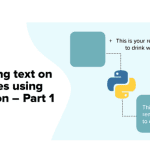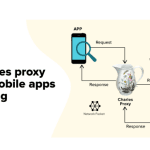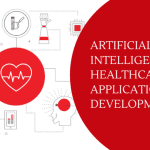Computer graphics teaches us how a pixel on a screen can be manipulated to draw beautiful shapes, artistic typography, eye-catching illustrations, make-me-look-good' photo-filters, and a lot more. Hardware manufacturers, researchers, software developers work together to build great products: smartphones, smartwatches, smart TVs, cameras all with the study of computer … [Read more...] about Putting Text on Image Using Python
Technical
Learn all about technical data and programming and why it's crucial for businesses. Get knowledge on how to collect and use this information to improve your products and services.
Charles Proxy for Mobile Apps Testing
At Haptik, we have our flagship mobile app built for Android & iOS. We have also built our SDKs (both Android & iOS) which could be plugged into any other app out there in the market and they could make use of Haptik chatbots inside their apps. There is actually a lot happening inside a mobile app. There is storage, network, computation, handling user messages, giving … [Read more...] about Charles Proxy for Mobile Apps Testing
Reactive Architecture: Benefits & Use Cases
While the term reactive architecture has been around for a long time, only relatively recently has it been recognized by the industry and hit mainstream adoption. The goal of this article is to analyze what reactive really is and why to adopt it. Its core meaning has been formalized with the creation of the Reactive Manifesto2 in 2013, when Jonas Bonér collected some of the … [Read more...] about Reactive Architecture: Benefits & Use Cases
AI in Healthcare Application Development: How Chatbots Are Digitizing Patient Care
Technology is expanding at a rapid pace, and the chatbot market is leading the pack. A recent study has revealed its surge at the rocket-speed and will reach $314 billion by 2023. So, there is no surprise that chatbot technology based on AI is seeing great demand among industries, and the healthcare industry is no exception. Another study conducted in the USA has shown that … [Read more...] about AI in Healthcare Application Development: How Chatbots Are Digitizing Patient Care
Optimize Return on Investments of RPA through Selection of the Right Processes for Automation
Robotic Process Automation commonly referred to as RPA has received wide acceptance across the world in process-centric and data-centric business environments. However, at times the process automation fails due to inadvertently automating the wrong processes. For deriving the optimal outcome and benefit of automation, businesses need to select the right processes and optimize … [Read more...] about Optimize Return on Investments of RPA through Selection of the Right Processes for Automation
What is technical data?
Technical data can be something as simple as a list of ingredients for a recipe or a more complex set of instructions for assembling a piece of furniture. Technical data can also be mathematical formulas or set points for calibration. No matter what form it takes, technical data is always designed to provide information that will help people to understand and use a particular product or service.
In some cases, technical data may be subject to special regulations, such as those governing the handling of confidential personal information. However, in general, technical data is considered to be publicly available information. Want to learn more about technical data? Datafloq has courses available. Contact us to get started.
What is the purpose of technical data?
Technical data is often used to create engineering drawings or specifications, which are then used to manufacture the product. Technical data can also be used to troubleshoot problems with a product or system.
For example, if a component is not working properly, technicians may refer to the technical data to determine the root cause of the problem. Technical data is an essential part of the product development process and can be very useful for businesses and consumers.
What are examples of technical data?
Technical data refers to the specifications of a product or system, including its performance, dimensions, weight, etc. It is often used in the context of engineering or manufacturing. For example, engineers will consider the vehicle’s weight, aerodynamics, and engine size when designing a new car.
Technical data can also be used to compare different products or systems. For example, if you are trying to decide between two different types of printers, you might look at their printing speed, paper capacity, and resolution.
What is technical data analysis?
Technical data analysis aims to help make better decisions by understanding the data better. Technical data analysis can be used for different purposes, such as predicting future events, identifying trends, or spotting outliers. Many different statistical methods can be used for technical data analysis, and the choice of method will depend on the type of data and the question you are trying to answer.
What is a high-tech startup?
A high-tech startup is a company that uses technology to create new products or services. These startups are usually founded by entrepreneurs with innovative ideas for a new business. Many high-tech startups are based around developing new software or hardware, but some may also focus on creating new medical devices or developing new clean energy technologies.
Whatever their focus, all high-tech startups share a common goal: to bring their innovative ideas to market and create value for their customers.
What is a high-tech business?
A high-tech business is an organization that develops or uses advanced technological processes and products in its operations. Many high-tech businesses are involved in research, development, engineering, and manufacturing. They often work with cutting-edge technologies, such as artificial intelligence, biotechnology, and nanotechnology.
These businesses typically require a highly skilled workforce and substantial investment in research and development. Due to the risky nature of developing new technologies, many high-tech businesses are venture-backed startups. However, some large companies, such as Google and Apple, are also considered high-tech businesses.







